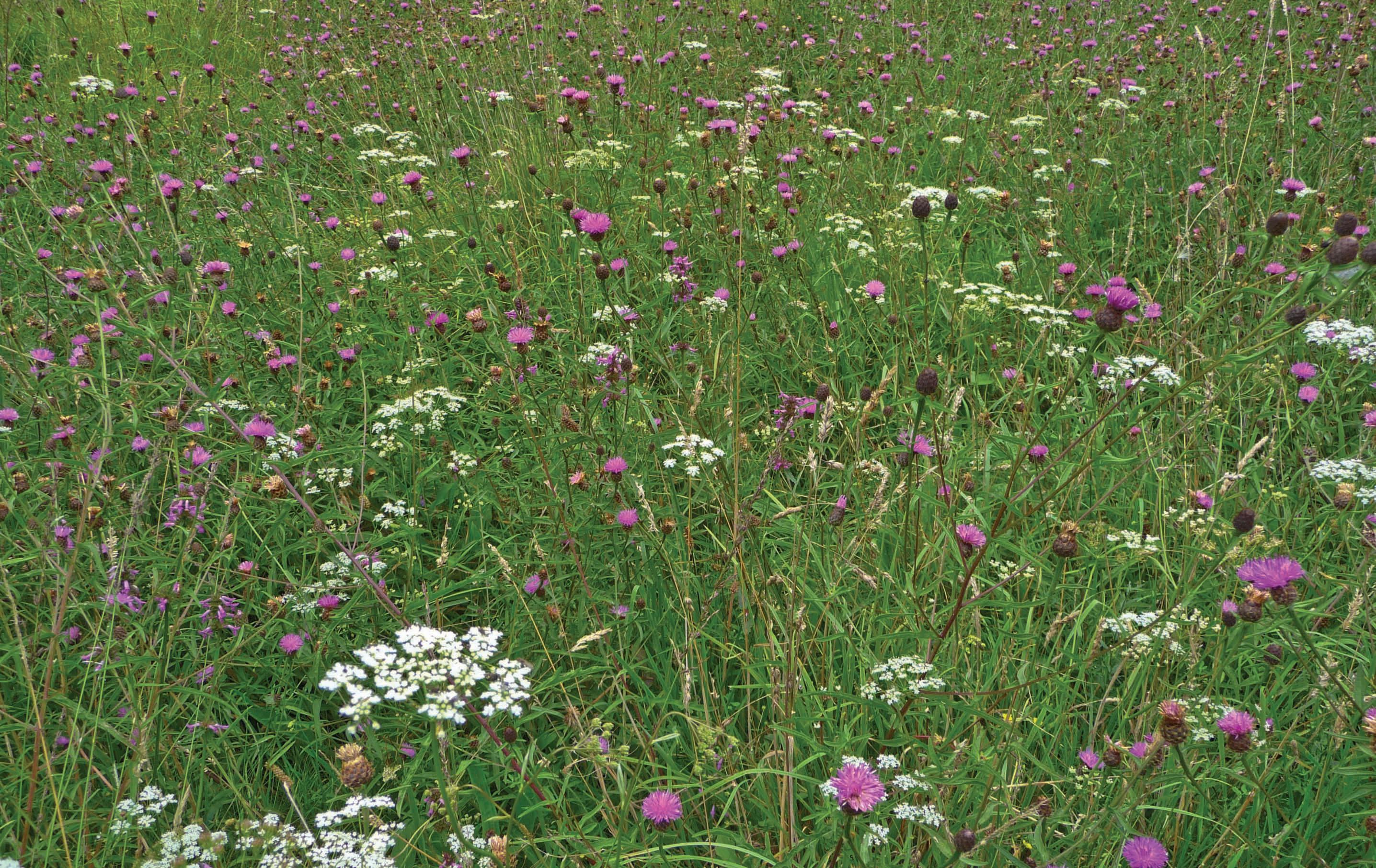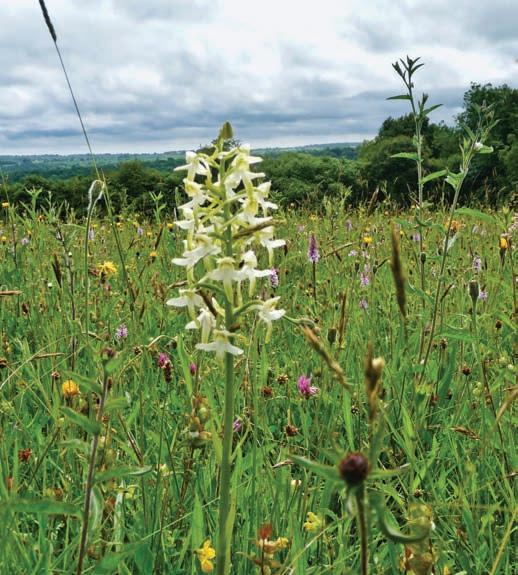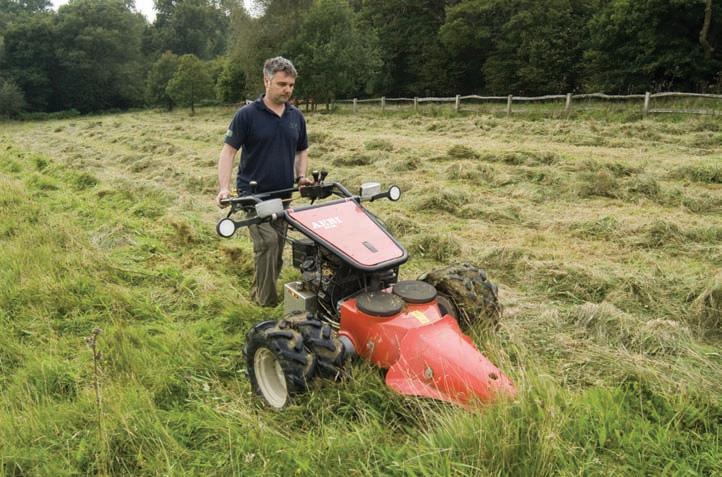
To all the volunteers who have come from different walks of life to learn botanical identification skills and have shared their expertise during many happy hours spent surveying meadows.
First published in Great Britain in 2012 by Papadakis Publisher An imprint of New Architecture Group Limited Kimber Studio, Winterbourne, Berkshire, RG20 8AN, UK
Tel. +44 (0) 1635 248833 info@papadakis.net www.papadakis.net Publishing Director: Alexandra Papadakis Design Director: Aldo Sampieri Editor: Sheila de Vallée

Whether they are hay meadows or grazed meadows, the meadows in this book are what we call ‘permanent’ grassland to distinguish them from short-term sown grassland (known as a ‘ley’) which is ploughed up and re-sown every few years. Many of them will not have been ploughed within living memory and some, like ancient woodland, may never have had their soil disturbed. There is a suite of plants associated with old or archaic grassland and these are featured in the next chapter.
kaleidoscopic meadows
Meadows look very different at different times of year as the various grasses and wildflowers come into bud, flower and fruit. Over winter, wildflower meadows look rather like any other grassy area giving an overall impression that grassland
habitats occur in abundance. This is one reason why even those who care passionately about the conservation of the countryside are often unaware of biodiversity loss in grassland habitats. Many meadow plants disappear below ground in winter and the indigenous grass species are difficult to identify without their flower spikes.
As spring progresses, the flowers of lady’s smock (Cardamine pratensis) and field woodrush (Luzula campestris) appear, and meadows begin to reveal their true colours. This is the best time of year to look for the curious adderstongue fern (Ophioglossum vulgatum) before the tiny green leaves and the spore-producing ‘tongue’ are hidden in the lengthening grass sward.
The bright yellow flowers of the much maligned dandelion provide a welcome early nectar source





above left: Catkin of male pussy willow flowers with bright yellow anthers on the end of long white stalks. At the base of each flower there is a dark-looking nectary – an essential food source for insects emerging from hibernation at the end of winter. The anthers contain pollen which is collected by colony-making queen bumblebees. Only queen bees survive through winter and each queen has to collect sufficient pollen to rear the first cohort of worker bees in her newly established colony.
above right: Catkin of flowers on a female pussy willow tree. Each flower is topped with a yellow stigma and has a prominent dark-looking nectary at its base. This provides a much-needed source of nectar for female bumblebees emerging from hibernation at the end of winter. Bumblebees are active at temperatures as low as five degrees centigrade, so are flying in March when not much is flowering in the countryside.
left: Lady’s smock, one of the first wildflowers to appear in meadows.
opposite: An attractive landscape in the High Weald of Sussex in April, but the bright green field surrounded by ploughed land is a sown grass ley like the field in the foreground which lacks wildflowers except for dandelions and white clover.

bumblebees. In the final chapter, we look at what is being done to conserve wildflower meadows.
Many wildflower plants are important nectar sources for adult butterflies; others provide nectar and pollen for bees and other beneficial insects; some show intimate connections between the flower structure and their insect pollinators; still others are eaten by the caterpillar stage of meadow butterflies or moths. The photographs in the following pages, illustrating the different wildflowers found in each type of meadow, have been chosen to reveal the connections between the wildflowers and a range of meadow insects.

receptable (ovary within)

sepal, one of five anther filament petal, one of five stigma style
understanding how flowers are pollinated
In order to understand the intimate connection between meadow flowers and pollinators such as bees and hoverflies, we need to be able to talk about the parts of a flower. For many of the wildflowers in this book, it is an incredible story and an appreciation of how pollination is effected can add immeasurably to our enjoyment of the flowers. So let us start with the parts of a fairly simple flower in the rose family and then we can elaborate on this as we deal with the many variations on this theme found in flowers in subsequent chapters.
In insect pollinated flowers, the pollen is transferred from the anthers of one specimen of a particular species of wildflower to the stigma of another specimen of the same species by insects which are attracted to the flowers by a nectar or pollen reward. The pollen grains are rough and sticky so that they stick to the insect’s body and then are transferred onto the receptive surface of the stigma as the insect brushes against it. In order
A diagram of the flower of agrimony to illustrate the flower parts of a typical wildflower. There are two whorls of petal-like structures: the outermost, which are green in agrimony, are sepals and inside the sepals are the showy petals which are yellow in agrimony. Then there are one or more whorls of stamens, the male parts of the flower. Each stamen consists of a pollen-bearing anther on the end of a stalk called a filament. There are 10 to 20 stamens in agrimony flowers; not all are shown in this diagram. And finally in the centre of the flower are the female flower parts which consist of a stigma which receives the pollen, a stalk of appropriate length to place the stigmatic surface where it will encounter pollen and an ovary which contains the ovules destined to become seeds after fertilisation by pollen. In the agrimony flower there are two stigmas. The female parts of the flower – stigma, style and ovary – are known collectively as carpels.
opposite above: Birdsfoot trefoil providing nectar for a bumblebee in a mid June meadow.
opposite below: Dandelions in a sown grass ley providing an early source of nectar for queen bumblebees emerging from hibernation.
to ensure that the pollen which becomes attached to the stigma is from a different specimen (so called ‘cross pollination’) the stigmatic surface is either not receptive to pollen from the same flower (selfincompatible) or matures at a different time to the anthers. Some flowers hedge their bets by also having a period in which self pollination can take place if cross pollination has failed to happen.
surviving and reproducing in the meadow. how meadow plants maintain their presence in the meadow.
Most meadow plants are perennial in their life habit. This means that an individual plant lives for more than one year in contrast to an annual plant which grows from a seed, produces flowers and seeds and then dies over the space of one year. A grassy sward makes it difficult for an annual plant to find an open space on the surface of the soil to germinate and grow into a tiny seedling, but never-the-less there are a few annuals which are characteristic of meadows. Mole hills and worm casts provide opportunities, and aftermath grazing

Wildflower meadows in lowland Britain have their origins in hay production. It is difficult for us to appreciate today, with our oil driven economy, how important hay was in the days of horse-drawn transport, and when ploughing was done by oxen. A large number of animals had to be maintained over winter when there was no fresh grass in the fields. It was crucial to have a good crop of hay and at the end of the 19th century an average of 4.5 million tons of hay were produced each year. Up until the middle of the last century the best land was given over to hay production, and hay meadows with their profusion of wildflowers were a familiar sight. Now they are vanishing at an unprecedented rate, their demise locked away in the memories of a passing generation. Here is a farmer in Sussex recalling a riverside hay meadow called Iron Gates in the late 1940s:
“The Iron Gates, in my day we always made hay… Because the grass there was a very fine grass and made beautiful soft hay, very suitable for feeding to calves.”
The meadow had been full of cowslips until he applied chemical fertiliser:
A typical landscape of old meadows along the River Hooke in Dorset. Up until the middle of the last century, hay meadows such as this were common alongside rivers and streams providing a connected landscape for meadow plants and pollinating insects.
“When I came here, the Iron Gates was full of cowslips and as soon as I applied some fertiliser, the cowslips disappeared completely and have never come back.”



catsear
Hypochoeris radicata
left: The splashes of yellow amongst the oxeye daisies in this June meadow are flowering heads of catsear. The ‘flower’ consists of a head of long thin strap-like florets all of which contain nectar and pollen: a bountiful supply of food for the many kinds of insects which visit the flower-head. One or more branched flower stalks each with several flower-heads grow out from the centre of conspicuous rosettes of hairy pimply leaves.
above: Like knapweed the ‘flower’ of catsear is really a collection of flowers or florets each with male and female flower parts, but this time the florets are asymmetrical and strap-like. The anthers are united into a long thin tube surrounding the style and pollen is shed into this tube before it opens. Unopened anther tubes are visible in the centre of the flower. Pollen is pushed out of the top of the anther tube in response to the stimulation of a visiting insect. When all the pollen has gone, the style emerges and the two arms of the stigma separate to expose the upper surface for the collection of pollen which may be from another plant.


After cutting the hay has to be turned. Until after the second world war this was largely done by hand or with a horse-drawn roller and chain. Albert remembered helping the nuns from the local priory turn the hay during the war:
above: Along with a revival in traditional countryside crafts, demonstrations of the agricultural use of heavy horses are popular. These heavy horses are a popular attraction as they harrow a meadow at Wakehurst Place in Sussex. A similar set-up would have been used in the past to turn hay with a roller and chain.
opposite above: Old horse-drawn mower, in production until the mid-1930s and subsequently converted for use behind a tractor.
opposite right: Cutting hay by hand-scythe in a small meadow in Devon, August 2010. The swinging action of the scythe is laying the hay in regular lines or windrows with a cut strip of meadow in between.
“There’s a field up here on the left hand side. Well the nuns would be out there in the summer turning the hay. I used to go from the farm here, with a horse and a roller and a chain and do it for them.”
Horse-drawn mowers superseded the hand-scythe and by the late 1940s, tractors had largely replaced the horses. These tractors, though, were quite unlike today’s models.
“The difference in the power of tractors … most of the time I was here, all the work was done with those little grey Ferguson tractors, but today they’re just a museum piece. They cost four hundred pounds new.

Today a new tractor would cost what, thirty five thousand? “ (97 year-old farmer interviewed in 2008)
Extra labour was brought in to make hay while the fine weather lasted. Here is Derek, interviewed in 2007 recalling his childhood in the 1950s.
“Our hay making was all done by hand … there was me grandfather, me father and me grandfather’s brother-in-law that used to work on the farm, but then when it came to haying in the summertime, we had three other people that came in for a bit of casual work and they worked down the local timber yard. So they would come in sort of about half past five and work through to about ten o’clock. Last orders at the Sheffield Arms was always about half past ten so it was always the last half an hour that they’d go down and have a drink. And grandfather would supply them with sort of supper.”




left: Great burnet flowering with oxeye daisies in Askrigg Bottom, a northern hay meadow (MG3) in Wensleydale, North Yorkshire. This upland type of hay meadow is almost completely restricted to a few valleys in northern England in Durham, North Yorkshire and the Lake District.
above: Snakeshead fritillaries flowering in the famous North Meadow at Cricklade. This type of lowland flood-plain hay meadow (MG4) is only found in a few scattered sites in the Midlands, and in southern Britain where seasonally-flooded land has been managed for centuries in the same traditional way. North Meadow is still cut for hay and then grazed in the autumn as common land.
overleaf: As the early flowers disappear, a mass of flowering common knapweed brightens up this Devon meadow in late July. A rich source of nectar, common knapweed occurs in great abundance in some meadows.


top left: Flower-head of oxeye daisy with visiting bee getting amply dusted with the copious pollen while probing for nectar. The ‘flower’ of both common daisy and oxeye daisy is really a head of tiny flowers. In the centre are symmetrical tubular flowers each composed of five yellow petals with stamens and stigmas inside. The head of tubular flowers is made more conspicuous for visiting insects by the encircling ring of white ray florets. These are asymmetrical and strap-like and do not produce any pollen. The yellow florets of oxeye are similar to the tubular knapweed florets described in chapter 1. When the flowers open, the stigmas protruding from the central florets are already dusted with pollen and the stamens have withered. A huge range of insects – bees, beetles, flies, butterflies and moths – visit oxeye daisy flowers for nectar secreted at the base of the petal tube and become covered in pollen. After several days the style opens out to expose three receptive stigmatic surfaces to capture pollen from another flower, but the receptive surfaces will also accept pollen from the same plant so self pollination is frequent. A large quantity of seed is produced which can germinate in the autumn or the spring and can remain viable in the soil for several years. This enables the plant to act like an arable weed and exploit areas where the soil has been disturbed such as roadside verges and heaps of spoil, but makes it less successful in a meadow context. It may be that the disturbance of the sward by aftermath grazing is essential to maintain the presence of oxeye daisy in meadows. I have noticed a decline in meadows managed by hay cutting without grazing.

top right: Common daisy flowering with meadow buttercup in a May meadow. The ordinary common daisy, a familiar plant of garden lawns and playing fields, and the much larger oxeye daisy are both diagnostic species for MG5a. Common daisy comes into flower really early in the year, sometimes at the beginning of March, and where the grass is cut or grazed at regular intervals it goes on flowering into autumn. Oxeye daisy on the other hand has a much more restricted flowering period and is particularly associated with June meadows.
above: Oxeye daisy flowering with common spotted orchids, red clover and birdsfoot trefoil in a June meadow.
opposite: Oxeye daisy is often sown into roadside verges, roundabouts and garden meadows. When sown it may be almost too successful producing a boring uniform sea of white flowers. Here, it has formed small patches of white in a natural meadow, adding contrast to the tapestry of colours amongst the grass. The basal leaves of this perennial plant can be found close to the ground all through winter, but as the flowering stem elongates and the vegetation of the meadow becomes taller, photosynthesis is taken over by leaves on the stem. The short rhizomes lead to little vegetative spread, and although large quantities of seed are produced oxeye daisy seems to be decreasing in meadows.














